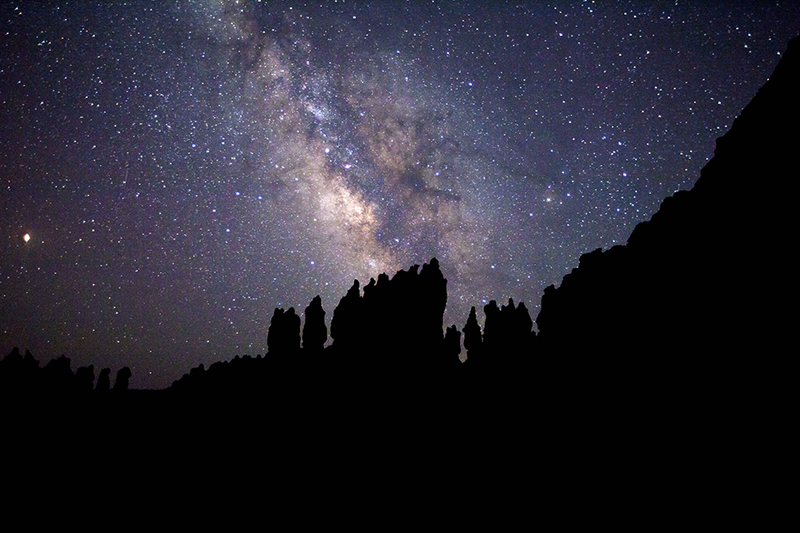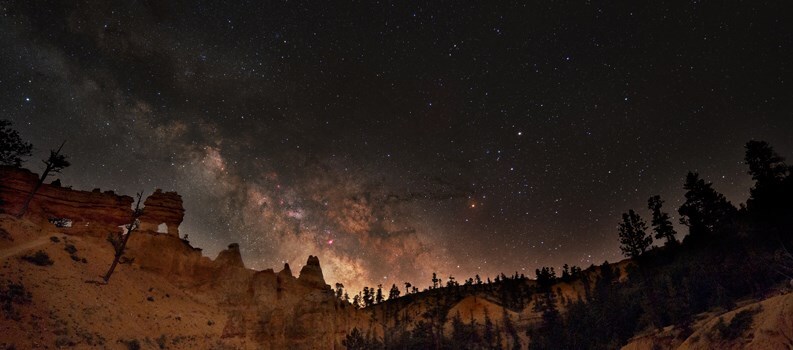Dark Sky over Bryce Canyon National Park

“The Milky Way glows brightly above the hoodoos of Bryce Canyon.” Keith Moore, last updated August 13, 2019. Courtesy of the National Park Service. https://www.nps.gov/brca/learn/news/bryce-canyon-national-park-certified-as-an-international-dark-sky-park.htm.
Creator: Keith MooreA national park filled with crimson rock formations known as hoodoos, Bryce Canyon also has one of the best-sustained public astronomical programs, and it has been running for over fifty years.
In addition to hosting the longest active program for astronomy in the National Park Service, Byce Canyon National Park also holds the honor of being a Gold Tier International Dark Sky Park, so designed by the International Dark-Sky Association in 2019. Gold Tier is a rare classification, as it denotes a place with natural nighttime conditions, little to no light pollution, and over 10,000 stars visible on a clear night.
President Warren G. Harding made Bryce Canyon a National Monument on June 8, 1923, but after a review, Congress made it a national park on February 25, 1928. Educational programs in Bryce Canyon National Park in Utah to teach visitors about astronomy began in 1969 when the Chief of Interpretation was inspired by the Abrams Planetarium to create a night sky interpretation program for Bryce Canyon. In 1972, an astronomer named Von Del Chamberlain wrote and designed a manual for sky interpretation for distribution and use at Bryce Canyon National Park. Chamberlain’s manual included cartoons about why natural skies were culturally important, a list of seven reasons for the park to include sky interpretation, and several program ideas focusing on campfires and storytelling. Interpretative rangers and volunteers have run educational lectures, stargazing parties, and constellation tours since then, and its reputation was such that interpreters from other parks came to Bryce Canyon to train for night sky and astronomy interpretation in 2005. Patrick Wiggins, Utah’s NASA Solar System Ambassador, has been an annual speaker at Bryce Canyon National Park and involved in program creations from 1984 to 2014.
The Dark Ranger program for park rangers, sometimes referred to as the Astronomy Rangers, was also created for Bryce Canyon National Park with a mission to cultivate understanding and wonder for the vastness of the universe that has grown harder to recognize with the expansion of lights and cities. Since 2013, the Astronomy Rangers have joined with the work of volunteers and other interpretive rangers for educational programs. Astronomical festivals have also joined Bryce Canyon’s list of public programs.
For Bryce Canyon’s dedication to over fifty years of defending an intangible but culturally crucial resource, the International Astronomical Union named an asteroid after Bryce Canyon National Park. Minor planet 49272 was discovered in 1998 by Roy Tucker, and it received the name “Bryce Canyon” in 2007 in appreciation for the park’s public astronomy programs. Orbiting the Sun between Mars and Jupiter, the asteroid has about the same length as its namesake on Earth, being three to five miles across. Bryce Canyon National Park is the second National Park to have an asteroid named after it. Though the small telescopes in Bryce Canyon National Park cannot see the dim minor planet in the sky, the park is very proud of its long record of promoting dark sky conservation. Having an asteroid named after the national park is an international honor.
Images

“The Milky Way glows brightly above the hoodoos of Bryce Canyon.” Keith Moore, last updated August 13, 2019. Courtesy of the National Park Service. https://www.nps.gov/brca/learn/news/bryce-canyon-national-park-certified-as-an-international-dark-sky-park.htm.
Creator: Keith Moore
“Milky Way Galaxy above hoodoos at Mossy Cave Trail.” Derek Demeter, June 2015. Courtesy of the National Park Service. Via Internet Archive. https://web.archive.org/web/20210223091940/https://www.nps.gov/brca/planyourvisit/astronomyprograms.htm.
Creator: Derek Demeter
“Yovimpa Point, Bryce Canyon National Park (southwest Utah).” Night Sky Team, last updated March 19, 2015. Courtesy of the National Park Service. https://www.nps.gov/cany/learn/nature/allskyimages.htm.
Creator: Night Sky Team